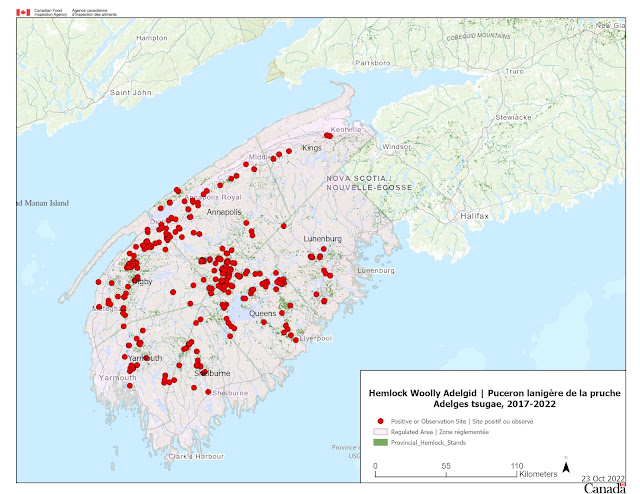 Initiated Mar 11, 2024 by BW on Annapolis Environment & Ecology (Public FB Group)
Initiated Mar 11, 2024 by BW on Annapolis Environment & Ecology (Public FB Group)
GOOD READ:: Hemlock Woolly Adelgid expert, Donna Crossland recently advised HRM regarding HWA — tells them to “get a plan” or lose all the Hemlocks. Story in the March 8th Halifax Examiner.
EXCERPT:
Crossland said when hemlocks die, they leave behind what she called “grey ghosts” in the forest.
“We’re already getting these big, dead stands in the southwest [of Nova Scotia],” Crossland said. “I’m sad to say, you’re going to be soon, next.”
She said there are “cascading effects” of this loss of hemlocks, including loss of habitats for wildlife and flora.
AND [Councillor Sam] Austin also wanted to know if the hemlocks could be replaced in those areas where the trees were killed by woolly adelgid.
Crossland said she wouldn’t suggest more investment in hemlocks, even though it’s her favourite tree. She said it would be better to replace the trees with red maple, oak, but also doing assisted migration of trees such as hickory and others from southern regions.
“They’re not going to get here on their own because we’re almost an island,” Crossland said. “We may need to think way out ahead. All of the rules have changed.”
Discussion about what to do with trees after they die
DGP: They are hardly going to save more than 1% I would guess. There are a lot of hemlock in Halifax Co. My bigger concern is what they do with the trees once they die. They should where\ever poss leave them to decompose naturally, make fire breaks etc if worried about fire.
Discussion about movement if firewood accelerating the spread of HWA
RN to DGP: well I visit First Lake elementary school last fall. In Lower Sackville there was a lot of Hemlocks around the school yard and HRM walking trails. I checked a few trees and they were infected with HWA. There are a lot of subdivisions & homes in that area. Some with campers and at the play ground, I asked a couple & their children if they ever camped at Keggi and the kids responded Yes we love Keggi. The year before when I visited & stayed at Keggi, I was astonished at how infected the trees were in the parking lot. Cars with trucks open packing up and taken HWA with them. How irresponsible of management to allow this !
DGP: Ouch. Blame that directly on NS Gov, first under the Liberals and continued under the PCs until recently (when they hit the Gosh we really have to do something button); they simply ignored the issue when surely we could have at least slowed the spread.
RN to DGP: since Keggi is a Federal Park, I blame it on the Federal Government and Provincal for allowing it. Very hypocritical for Park to seize any firewood coming into Park to prevent disease or insects from coming into park but no proactive measures to prevent HWA from going out of park. Where people come all over the world to visit. Wow Yes we sure can not stop the spread from birds but could at least try to prevent from humans.
BW to RN:Just looking at the map of where HWA spread earlier on in Nova Scotia, I would say there was probably much more spread by logging equipment than anything else. It spread all up through Clare and Digby into Annapolis and even onto the North Mountain early on. I was up on Hollow Mountain Road several years ago and a friend and I found it in an area that definitely is not frequented by hikers, but would have been by logging crews. It can be spread so easily on any woody debris that it would easily be spread on logging trucks. Keep in mind also that a lot of people with infected forests in SW Nova Scotia quickly salvage harvested their forests. While there were restricted areas — logs weren’t supposed to be shipped out of — I sincerely doubt that all of the logging equipment that was in there harvesting was doing major biocontrols after working in those areas and certainly, as they drove out of those places on the way to mills, there was probably lots of HWA flying around as they drove along the highways. Here’s a map from 2022. I think my friend and I found the HWA on Hollow Mountain Road in early 2020 or maybe even 2019.
I think most of the spreading had already taken place before this map. A later map would probably show even more of it around Lunenburg and Bridgewater, which would make sense as there is a lot of logging in those areas as well as mills that were probably processing Hemlock.

RN to BW:
BW to RN Interesting why did not CFIA shut things down tighter & earlier!
Discussion about effects of the insecticide
GF: I’m puzzled by response I get . I read the msd sheet on this product. It can be used as a liquid placed around the base of trees . It’s not done in this case because it will likely translocate to near by streams . It’s deadly on fish. I believe it recommended that you don’t use it with in 50 ft of stream . That means a 100 ft swath total width on stream never treated. Those trees will die . It would appear this product consistency and strength is not effected by soil contact , unlike other products. It will stay active for 5 years in the tree . Does this mean a 75 ft tree that blows over with its top In a stream will cause this product to leach into the stream until the tree dies ? I hear arguments about saving pine marten in these areas so keep trees alive . Well the product goes into the cone seeds , the seeds are eaten by squirrels, squirrels are the prime food source for marten …well da ! The work around that one was posted we need to use it to now save biodiversity….Why are no silvicultural trials being done , not even in the areas we know will never be treated ? Always talk about smaller gear in the forest and smaller contractors. There is this type gear aviable, one being a member of this site . No action . I guess it will get worked through. If you want seedling as a wood lot owner , the only province growing acadian forest complete species mix is PEI. You will need to place orders early , likely a couple years so they can ramp up production. Yes they grow hemlock .
BW to GF: Why don’t you take some time to read some of the studies on imidicloprid treatment of Hemlock for HWA that have been done in the U.S. where they have been using it for several years. I’ll give you a URL for that. However, let’s look at this study that was done on streams above and below areas where imidicloprid had been used to treat forest.
—-
PERSISTENCE IN WATER:: The half-life of imidacloprid in water has been recorded from one hour to three days (Agüera et al., 1998, Moza et al., 1998, Wamhoff and Schneider, 1999), and half-life can vary by season, ranging from estimates of 8.6–52.8 h, with slower photodegradation occurring in the winter (Lu et al., 2015). In the absence of light, imidacloprid is stable in water for more than 12 h. However, when exposed to light complete degradation has been documented in less than five hours (Agüera et al., 1998).
[MY NOTE: As you can see, when it does enter water, it does not persist for very long at all]
CONCENTRATIONS IN WATER:: Here, I quote a couple of paragraphs. In case you don’t know, a “μg” is a microgram — and an “ng” is a nanogram. It takes 1000 ng (nanograms) to make 1 μg (microgram). Don’t get these two confused because the amount of imidicloprid that is actually found in water samples was measured in “ng” nanograms (the much smaller unit) and the baseline for acceptable presence that might possibly cause some effect is measured in “μg” micrograms (the larger unit that is 1000 times larger than a nanogram.
EXCERPT FROM LINKED STUDY::
[PLEASE PAY PARTICULAR ATTENTION TO THE UNITS DESCRIBED — the “μg” micrograms, and the “ng” nanograms (that are 1/1000th of a microgram)]
Imidacloprid was detected in streams associated with imidacloprid treatments for the control of HWA in this study (Table 2). All stream locations where imidacloprid was detected were downstream from imidacloprid treatment areas. Imidacloprid was detected in seven out of ten downstream locations, and imidacloprid concentrations ranged from 28.5 to 379.1 ng L−1. In six of the streams where imidacloprid was detected the concentration of imidacloprid was below 100 ng L−1. Dunn Creek, with a documented
Discussion
The potential risk of imidacloprid from hemlock treatments to leach through soil, enter surface water, and cause associated negative impacts on water quality and aquatic biota is an issue that scientists, regulators, and land managers must consider. According to the USEPA, the Chronic and Acute Aquatic Life Benchmarks of imidacloprid for fish is 1200 and 41,500 μg L−1, respectively. Aquatic invertebrates have much lower Chronic and Acute Aquatic Life Benchmarks of 1.05 and 34.5 μg L−1, respectively
Conclusions
Imidacloprid was present downstream from imidacloprid treatment areas in seven of ten streams, and the presence of imidacloprid was not observed in upstream and adjacent stream samples. The highest concentration observed, 379.1 ng L−1, was below USEPA Aquatic Life Benchmarks for chronic toxicity of imidacloprid to aquatic invertebrates. Six of the seven streams where imidacloprid was documented had concentrations below 100 ng L−1, less than one tenth of the USEPA Chronic Aquatic Life Benchmark. No
https://www.sciencedirect.com/…/abs/pii/S037811271500585X
Okay, now let’s address your other concern about Squirrels being exposed to Imidicloprid and then being eaten by Pine Martens. You may or may not know this, but Imidicloprid is a very frequently used treatment for prevention of fleas and ticks in dogs and on other mammals. Products such as Advantage and Advantix are made of imidicloprid and are used to kill fleas and ticks. Why do I mention this and what has this got to do with squirrels? Well, when I used to travel in California, many campgrounds in the Sierras have warnings about to avoid contact with rodents and keep your pets away from them. Small rodents such as Ground Squirrels, Chipmunks, etc.. can carry fleas that spread the Plague. There have been laboratory studies where Ground Squirrels and other rodents have been treated with imidicloprid, or have had it sprayed onto bedding material where they would be sleeping. Both are considered acceptable with no toxicity, and the treatment killed the fleas that are the vector for the plague. Actually though, if you were to read this study, you would find that imidicloprid had a limited time effectiveness compared to Fipronil – another topical treatment which is used in Frontline (I used Frontline on my dogs to keep ticks off of them). Fipronil turned out to have a much superior length of effectiveness compared to Imidicloprid, which wore off rather quickly — so even if a Squirrel were to absorb some of it, it would be gone again out of its body quite quickly — and the amount it absorbed would be very small — and it should not bother a Pine Martin either — might even do it some good in killing off any ticks that might be fastened to it. Anyhow, here’s the study if you want to read more. There are more studies like this around, but this is a good starting place.
https://academic.oup.com/…/article…/39/1/152/879398

